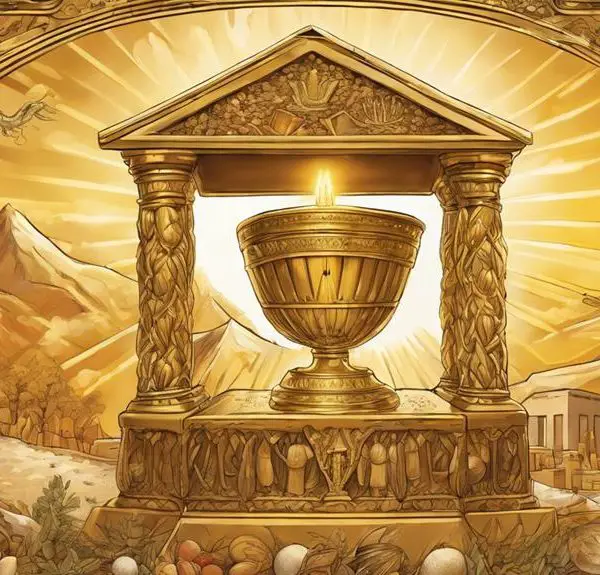Within the Bible, tempests symbolize divine judgment and transformation, inviting a deeper exploration of faith amidst life's storms.

Tempest Meaning in the Bible
In the Bible, tempests both wreak havoc and herald new beginnings, placing you at the crossroads of fear and faith. These storms aren't merely meteorological events; they're laden with symbolism, often representing divine judgment or significant transformation.
As you explore their depths, you'll discover that tempests also serve as a backdrop for demonstrating divine power and mercy, particularly through the actions of Jesus. This duality invites you to ponder deeper questions about the role of turmoil in spiritual growth and divine intervention.
Could understanding these biblical storms offer you insights into navigating your own life's tempests? Let's uncover what lies beneath their turbulent surfaces.
Key Takeaways
- Tempests in the Bible symbolize divine communication, judgment, and the potential for personal and communal transformation.
- They are not merely weather events but pivotal elements that shape narratives and reveal deeper truths about the human condition.
- Storms represent a test of faith, challenging believers to trust in divine authority and prompting introspection and spiritual awakening.
- The calming of storms by Jesus highlights the power of faith over fear and reassures believers of the divine presence and intervention.
Defining Biblical Tempests

What exactly are Biblical tempests, and how do they manifest within the sacred texts? In your exploration of scripture, you'll find that tempests, essentially violent storms, play critical roles across various narratives. These aren't merely meteorological events; they're rich in theological and historical layers. When you dissect the types of tempests mentioned, you'll uncover a spectrum ranging from fierce winds at sea to tumultuous desert sandstorms. Each type serves a distinct purpose, whether as divine intervention or a test of faith.
Delving into historical tempests within the Bible, it's fascinating to observe how these events are anchored in real geographical and historical contexts. For instance, the storm that swallowed Jonah's ship reflects the perilous conditions ancient mariners faced in the Mediterranean. Similarly, the tempests described in the Exodus narratives mirror the harsh, unpredictable weather patterns of the Near East, emphasizing the Israelites' struggles and resilience.
Through this analytical lens, you're not just reading about weather phenomena; you're engaging with a layered tapestry of faith, history, and human experience. Biblical tempests, therefore, are far more than historical footnotes; they're pivotal elements that shape narratives and reveal deeper truths about the human condition in relation to the divine.
Symbolism of Storms in Scripture

In the biblical narrative, storms often symbolize divine communication or intervention, reflecting the complex relationship between humanity and the divine. This imagery evokes a profound understanding of the storm's repentance and navigational faith, serving as a metaphor for spiritual awakening and the journey towards redemption. Storms in Scripture are not merely meteorological phenomena but are imbued with rich theological significance, challenging you to reflect on the tumultuous aspects of your faith and the potential for renewal that follows.
Emotion |
Symbolism |
|---|---|
Fear |
The immediate reaction to a storm, representing the awe and reverence one feels in the face of divine power. |
Hope |
The aftermath of a storm, symbolizing the clarity and renewal that can follow repentance and faith. |
Transformation |
The personal change that occurs through navigating the storm, embodying the journey from fear to faith. |
Analyzing these elements, you'll find that storms in Scripture are multifaceted symbols. They not only represent divine wrath or correction but also signify a deep, transformative process. It's through the storm's repentance and the cultivation of navigational faith that you're invited to explore the depths of your relationship with the divine, emerging renewed and strengthened on the other side.
Tempests as Divine Judgment

Exploring further, we find that tempests in biblical contexts often serve as manifestations of divine judgment, compelling us to reconsider our actions and their alignment with divine will. These natural phenomena aren't merely meteorological events but are imbued with profound theological significance.
In the historical context, a tempest could devastate communities, alter landscapes, and decisively impact the course of human events. Through this lens, tempests become divine communications, warning signs of misalignment between human behavior and divine expectations.
The Bible presents numerous instances where tempests symbolize the consequences of collective or individual transgressions. This perspective invites a reflective analysis of how we interpret challenges and adversities in our lives. Are these merely random occurrences, or could they be understood as part of a broader divine narrative, urging us to introspection and change?
Transformation Through Turmoil

Tempests, as divine instruments, often catalyze profound personal and communal transformation amidst turmoil. In the biblical narrative, these storms aren't merely physical phenomena; they're emblematic of life's unpredictable challenges that test one's faith and resilience. You're confronted with the raw power of nature, which mirrors the tumultuous periods in your spiritual journey, prompting a deep introspection and realignment with your core beliefs.
This process isn't straightforward or painless. It's a crucible that forges personal growth and a crisis of faith into stepping stones towards enlightenment. The tempests you face compel you to question and, eventually, strengthen your reliance on a higher power. In the midst of chaos, when you feel most vulnerable, there lies an opportunity for significant spiritual renewal and deepening of faith.
Such transformation is seldom a solitary journey. It's shared within communities, where collective experiences of hardship and recovery can foster a stronger, more cohesive faith network. As you navigate through the storm, you not only discover your resilience but also the invaluable support of those around you, bound by shared adversity. This communal aspect of overcoming tempests underscores the interconnectedness of personal growth and collective faith, highlighting the profound impact of turmoil on human development and spiritual awakening.
Jesus and the Calming of Storms

One pivotal narrative that illustrates the power of faith over fear involves Jesus calming the storm, offering a profound lesson on trust and divine intervention. This story, deeply embedded within the Christian tradition, acts as both a literal and metaphorical beacon of hope. It's a vivid demonstration of Jesus' power and a call to unwavering faith amidst life's tempests.
Analyzing this narrative, you'll find:
- Faith testing: The disciples' fear contrasts sharply with Jesus' calm, highlighting a test of faith. You're invited to reflect on your own reactions to personal storms. Do you panic, or do you trust?
- Divine authority: Jesus' command over nature underscores divine authority over all creation, reinforcing the belief in His omnipotence. It's a reminder that, in the presence of divine will, chaos returns to order.
- Miracle interpretation: The miracle serves multiple interpretations; it's not only about silencing a storm but also about quieting the turmoil within. It encourages a deeper faith that can calm internal tempests.
- Community reassurance: Finally, this act of calming the storm reassures the community of believers. You're not alone in your boat; faith in the divine presence offers solace and strength amidst life's upheavals.
Reflecting on this narrative, you're led to understand the profound interplay between divine intervention and human faith, a cornerstone of spiritual resilience.
Frequently Asked Questions
How Do Different Biblical Translations Vary in Their Depiction of Tempests, and What Impact Does This Have on Interpretation?
You'll find that different biblical translations vary significantly in depicting tempests due to translation accuracy and linguistic evolution. This variation impacts interpretation deeply, as each version may convey subtly different connotations or emotional intensities.
These differences highlight the nuanced complexities of translating ancient texts into modern languages, reflecting both the progress and challenges in understanding biblical narratives. Reflecting on these variations encourages a richer, more layered engagement with the scripture.
Are There Any Lesser-Known Stories or Books of the Bible Where Tempests Play a Significant Role Not Covered in Mainstream Discussions?
Yes, you'll find lesser-known tales in the Bible where tempests hold deep meaning.
Consider the story of Jonah, not just for its maritime narrative but for its prophetic symbolism. Here, the storm isn't just a physical challenge; it represents Jonah's internal strife and the consequences of running from divine missions.
This narrative invites you to reflect on the broader implications of tempests beyond their immediate, chaotic appearances in biblical contexts.
How Have Historical and Cultural Contexts Influenced the Understanding of Tempests in the Bible Over Time?
As you delve into how historical and cultural contexts have shaped the understanding of tempests, you'll find climate symbolism and maritime practices pivotal. These elements not only reflect the physical realities of past societies but also their spiritual interpretations.
Tempests, thus, aren't just meteorological events; they're laden with meanings that have morphed over time, influenced by changes in climate awareness and seafaring habits. Reflecting on this offers a profound glimpse into humanity's evolving relationship with nature.
In What Ways Have Interpretations of Biblical Tempests Influenced Art, Literature, and Music Throughout History?
You've seen how interpretations of tempests have deeply influenced art, literature, and music, mirroring storm symbolism's potent effect on human emotion.
In maritime art, these portrayals often reflect not just the literal storms but also the tumultuous struggles within the human spirit.
This thematic use across mediums showcases how artists and writers have historically used the metaphor of the storm to explore themes of chaos, transformation, and ultimately, hope.
How Do Modern Theologians Reconcile the Concept of Tempests as Divine Judgment With Contemporary Understandings of Natural Disasters and God's Nature?
You're diving into how theologians mesh divine judgment with nature's fury and God's compassion. Interestingly, 85% find a balance between divine compassion and scientific explanations.
They reflect deeply, suggesting that natural disasters aren't punitive but part of the Earth's dynamics. This shift from seeing tempests as divine wrath to understanding them through scientific lenses, while still acknowledging God's nurturing character, showcases an evolved theological perspective that's both analytical and reflective.
Conclusion
In essence, tempests in the Bible aren't just atmospheric disturbances; they're profound metaphors for life's upheavals and divine interventions.
You've seen how storms symbolize judgment, transformation, and even the power of faith through Jesus' calming of the sea.
Remember, every cloud has a silver lining.
These biblical tempests remind you that amidst life's fiercest storms, there's always a potential for growth and divine guidance, encouraging a deeper reflection on the storms within your own life.



Sign up